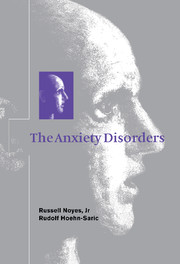Book contents
- Frontmatter
- Contents
- Preface
- 1 Normal anxiety and fear: psychological and biological aspects
- 2 Generalized anxiety disorder
- 3 Panic disorder and agoraphobia
- 4 Social phobia
- 5 Specific phobia
- 6 Posttraumatic stress disorder
- 7 Anxiety in the medically ill: disorders due to medical conditions and substances
- Index
2 - Generalized anxiety disorder
Published online by Cambridge University Press: 22 March 2010
- Frontmatter
- Contents
- Preface
- 1 Normal anxiety and fear: psychological and biological aspects
- 2 Generalized anxiety disorder
- 3 Panic disorder and agoraphobia
- 4 Social phobia
- 5 Specific phobia
- 6 Posttraumatic stress disorder
- 7 Anxiety in the medically ill: disorders due to medical conditions and substances
- Index
Summary
Definition
Generalized anxiety disorder is a chronic disturbance characterized by excessive anxiety and worry. It is a newly described disorder about which much uncertainty exists. Its resemblance to normal anxiety and lack of distinctive features have contributed to poor diagnostic reliability. The relative mildness of symptoms and high rates of comorbidity have caused some to view it as an associated feature of other disorders. Nevertheless, depending upon where the threshold is set, generalized anxiety disorder is common, and its chronicity and comorbidity add to its overall impact. Most persons with the disorder are seen by primary care practitioners and, partly for this reason, it remains the least studied of the anxiety disorders.
Generalized anxiety disorder first appeared in DSM-III as a residual category, although chronic free-floating anxiety was described as early as 1895 by Freud. Also, the description in DSM-III bore a resemblance to trait anxiety, conceptualized by Speilberger (1972) and others. When panic disorder was removed from the earlier diagnostic category, anxiety neurosis (DSM-II), what remained was labeled generalized anxiety disorder (American Psychiatric Association, 1968). The observation by Klein & Fink (1962) of two anxiety syndromes that were differentially responsive to drugs was important in defining the new category. They observed that imipramine blocked panic attacks but that benzodiazepines might be more effective for anticipatory anxiety (Klein, 1981).
Diagnostic criteria
Generalized anxiety disorder first appeared in DSM-III (American Psychiatric Association, 1980). As initially defined, its essential feature was one of generalized, persistent anxiety manifested by symptoms grouped under four headings.
- Type
- Chapter
- Information
- The Anxiety Disorders , pp. 37 - 85Publisher: Cambridge University PressPrint publication year: 1998



